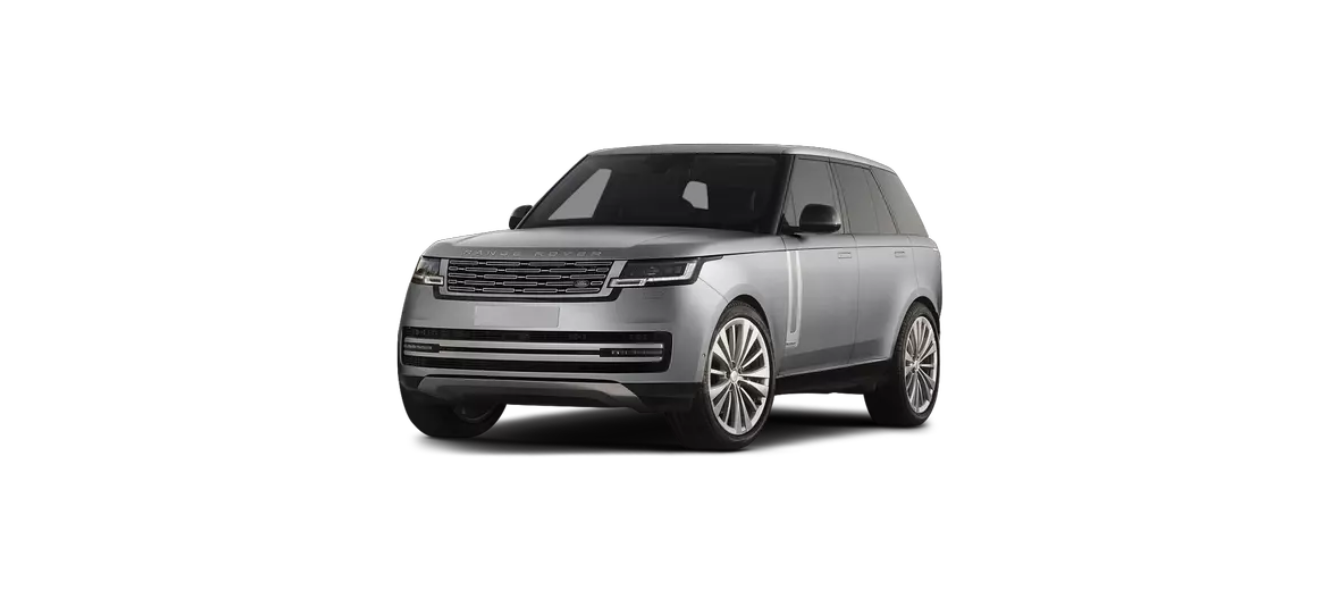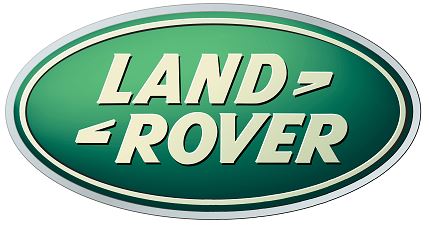2022 Land Rover Range Rover Fuel And Refueling

SAFETY PRECAUTIONS
Make sure that the following warnings have been read and understood. Failure to observe the warnings could result in an accident, leading to serious injury or death.
Do not smoke, use an exposed flame, or cause sparks while refueling.
Avoid exposing the fuel gases to any potential sources of ignition.
Switch off the engine when refueling, as it is both a source of extreme temperature and electrical sparks.
When refueling, switch off any personal electronic devices such as cell phones or music players.
Take note of all warnings and instructions given on the label affixed to the inside of the fuel filler flap.
The fuel system is designed to make sure that spillage does not occur. Do not attempt to fill the tank past its maximum capacity.
1Make sure that the fuel filler nozzle is fully inserted into the filler neck. If the nozzle is inserted loosely, fuel spillage may occur.
When refueling, make sure that all of the windows, doors and panoramic roof are fully closed. Use extreme care and caution if young children or animals are in the vehicle.
Only use containers specifically designed for carrying fuel, and always remove them from the vehicle to fill them.
GASOLINE ENGINED VEHICLES
Use high-quality fuel with detergent. Low-quality fuel can damage the engine and reduce engine performance.
Do not use leaded fuels, fuels with lead substitutes, e.g., manganese-based, or fuel additives. The vehicle’s emission control systems can be adversely affected, which may affect the vehicle’s warranty coverage.
Fuel system cleaning agents should not be used unless approved by the vehicle manufacturer. Inadequate cleaning agents may damage the fuel system.
OCTANE RATING
Do not use fuels with an octane rating lower than 87 AKI as severe engine damage may occur.
Do not use leaded fuels, fuels with lead substitutes, e.g., manganese-based or fuel additives. Doing so may adversely affect the vehicle’s emission control systems and affect the vehicle’s warranty. The vehicle manufacturer recommends the use of premium unleaded gasoline with a minimum octane rating of 91 AKI (Anti-Knock Index). Using the correct fuel specification helps to maintain the vehicle’s performance, fuel economy, and driveability. If premium unleaded fuel is not available, use unleaded fuel with a lower octane rating, down to a minimum of 87 AKI. Using a lower specification fuel may reduce the vehicle’s performance, increase fuel consumption, cause an audible engine knock, and other driveability problems. Consult a retailer/authorized repairer if an engine knock is detected while holding a steady speed on level roads. Also consult a retailer/authorized repairer if a heavy persistent engine knock is detected, even if using fuel to the recommended octane rating. Failure to do so is a misuse of the vehicle which is not covered by the vehicle’s warranty.
An occasional, light engine knock when accelerating or climbing hills is acceptable.
Federal law requires that gasoline octane ratings be posted on the pumps.
ETHANOL
Do not use fuels containing more than 15% ethanol. Inadequate fuel can reduce engine performance and may cause damage to engine components.
Do not use E85 fuels with 85% ethanol content, as serious engine and fuel system damage will occur. Fuels containing up to 15% ethanol may be used, e.g., E10 and E15. Make sure that the fuel has octane ratings no lower than those recommended for unleaded fuel. Most drivers do not notice any operating difference with fuel containing ethanol. If driveability issues are experienced, revert to using fuel containing no more than 10% ethanol. If the issues remain, use premium quality unleaded fuel instead.
METHANOL
Wherever possible, avoid using fuel containing methanol. Using fuel containing methanol may cause serious engine and fuel system damage, which is not covered by the vehicle’s warranty.
METHYL TERTIARY BUTYL ETHER (MTBE)
Unleaded fuel containing an oxygenate known as Methyl Tertiary Butyl Ether (MTBE) can be used. The ratio of MTBE to conventional fuel must not exceed 15%. MTBE is an ether-based compound derived from gasoline. MTBE has been specified by several refiners as the substance to enhance the octane rating of the fuel.
DIESEL ENGINED VEHICLES
If the fuel tank is inadvertently filled with gasoline instead of diesel, do not attempt to start the engine. In this event, contact a retailer/authorized repairer immediately. Inadequate fuels may damage the fuel system and engine components.
Any damage caused by running the vehicle with fuel other than that stipulated is not covered under warranty.
If a diesel engine is difficult to start in extremely cold temperatures of 5°F (-15°C) or less, consult a retailer/authorized repairer for assistance. Use high-quality diesel fuel, in accordance with the American Society for Testing and Materials standard (ASTM) D975 Ultra Low Sulfur Diesel (ULSD), or an equivalent standard. The vehicle has the latest after-treatment systems to meet the US Low Emissions Vehicle (LEV) standards. To make sure of emissions compliance and maintain correct engine performance, only the use of ULSD fuel is recommended. The recommendation is in accordance with the ASTM D975 ULSD standard. Do not use any fuel additives. Do not add paraffin or gasoline to diesel fuels.
Do not use bio-diesel blends above 20% (B20). Inadequate blends may damage the vehicle’s engine or fuel system.
Bio-diesel blends above 5% (B5) are not recommended. Higher proportions may damage the vehicle’s engine or fuel system. Bio-diesel is a blend of diesel fuel and biofuel. Bio-fuel is produced from renewable and crop-based sources such as rapeseed, palm oil, food waste, animal fat, etc. The properties and characteristics of bio-diesel can vary significantly, according to the source of the biofuel and ambient conditions. Highway diesel fuel in the US is generally known as Ultra Low Sulphur Diesel (ULSD). ULSD can contain up to a maximum of 5% bio-diesel (B5), in accordance with ASTM D975 ULSD standard. Some states in the US offer incentives to use bio-diesel blends higher than 5% biofuel. Bio-diesel is required to be clearly labeled on the fuel pump, according to the percentage of the bio-diesel blend. For example, B10 is 10% bio-diesel, B20 is 20% bio-diesel, etc. The vehicle is designed to run with fuel at a maximum blend of 5% bio-diesel (B5). Jaguar Land Rover encourages the use of ULSD in accordance with ASTM D975, which has a maximum of 5% bio-diesel (B5). Continuous and prolonged use of B10 and/or B20 can lead to fuel system blockages and degradation of engine oil lubricating properties.
If the use of B10 and/or B20 is unavoidable, the following is recommended:
- Check the engine oil level weekly. If any noticeable increase in engine oil level occurs, regardless of the mileage since the last service, contact a retailer/authorized repairer for advice. See CHECKING THE ENGINE OIL LEVEL.
- Adhere strictly to the service schedule.
- Fill the fuel tank with ULSD conforming to ASTM D975 ULSD standard if the vehicle is not going to be driven for a period of several weeks.
SULFUR CONTENT
Using an incorrect specification of fuel will cause serious damage to the engine and the exhaust after-treatment system. The vehicle’s warranty does not cover this. If in doubt, contact a retailer/authorized repairer for advice. Vehicles with a diesel engine require the use of Ultra Low Sulfur Diesel (ULSD) fuel. The sulfur content is in accordance with the American Society for Testing and Materials standard ASTM D975 ULSD, or the World Wide Fuel Charter (WWFC) standards. The fuel must also meet the Environmental Protection Agency (EPA) standards. This vehicle must be operated only with ultra-low sulfur diesel fuel (that is, diesel fuel meeting EPA specifications for highway diesel fuel, including a 15 ppm sulfur cap).
DIESEL EXHAUST FLUID (DEF)
Diesel Exhaust Fluid (DEF) must be kept out of children’s reach, to avoid serious injury or death.
Read the label for safety precautions when using DEF, to avoid injury.
DEF must be stored in the original container, in a cool, dry, and well-ventilated area. Observe the manufacturer’s storage and handling recommendations.
DEF has a strong odor and can stain clothing or upholstery. Take care not to spill the fluid when performing a top-up procedure. In the event of spillage, rinse immediately with clean water.
When refilling, make sure that the correct specification of DEF is used. Use of the incorrect fluid can result in serious damage to the vehicle. In this situation, do not start the engine, contact a retailer/authorized repairer immediately.
Do not overfill the DEF tank.
Do not use commercial vehicle DEF dispensing nozzles. The vehicle’s DEF system is not designed to be refilled under these higher pressures. Vehicles with a diesel engine have a tank containing Diesel Exhaust Fluid (DEF). DEF is used to make sure that correct exhaust emissions are achieved. DEF is also known as AdBlue®, AUS 32, and ARLA 32. AdBlue® is a registered trademark of the Verband der Automobilindustrie e.V. (VDA). Dependent on the current geographical location, the correct use of the DEF system may be a legal requirement. Running the vehicle without the correct specification of DEF may be a criminal offence. Always use the correct DEF specification, and the correct quantity of DEF. See LUBRICANTS AND FLUIDS, and also see CAPACITIES. The consumption of DEF can vary greatly. An average of 0.74 US gallons (2.8 L) of DEF is used per 1 000 miles (1 600 km), but this consumption rate can be significantly affected by driving style, road, and weather conditions. The distance until the DEF tank is empty and the volume of DEF required for refill can be viewed in the vehicle’s instrument panel:
- Switch on the ignition. See SWITCHING ON THE IGNITION.
- Press the MENU button on the steering wheel control.
- Use the steering wheel control to navigate to highlight Vehicle info.
- Press the OK button to confirm the selection.
- Scroll down to highlight the Next service.
- Press the OK button to confirm the selection. The Diesel Exhaust Fluid range and refill volume are displayed.
The instrument panel displays a series of messages when the DEF level becomes low, the volume of DEF required for refill also accompanies each message:
- The first message states that the DEF level is at a level where a top-up is advised.
- The second message is accompanied by an AMBER warning icon and states to refill the DEF tank.
- The third message starts a countdown of the distance remaining until the DEF tank is empty. After the countdown, the vehicle start is inhibited.
- The final message is accompanied by a RED warning icon and is displayed when the distance remaining is zero and states that no further restarts are possible until DEF is added to the tank.
- When the DEF level becomes low, a notification message displays in the message center.
- Refill the DEF tank at the earliest opportunity.
- A retailer/authorized repairer can be contacted to arrange a full DEF refill.
- To perform a full DEF system refill, it is recommended to contact a retailer/authorized repairer.
- If required, DEF can be added to the tank by following the top-up procedure.
- The volume of DEF required to top-up or restart the engine is displayed in the instrument panel.
- To perform a DEF top-up procedure, locate the DEF filler. See FLUID FILLER LOCATIONS.
Then, follow the steps below:
- Turn the tank filler cap counterclockwise to remove it.
- Making sure not to exceed the required volume, top up the tank following the instructions given on the DEF container.
NOTES
Non-drip bottles are the recommended method for a top-up.
- Replace the tank filler cap and continually turn clockwise until the hand is tight.
If a DEF warning lamp or a message illuminates with a red warning icon, seek qualified assistance at the earliest opportunity. The possible events for this include DEF system malfunctions, incorrect fluid, and fluid quality. See DIESEL EXHAUST FLUID (DEF) (RED), and also see DIESEL EXHAUST FLUID (DEF) (AMBER).
In extremely low temperatures below 14°F (-10°C), DEF may freeze in the tank, making refilling difficult. Move the vehicle into a warmer environment, e.g., a garage. Raise the ambient temperature, in order to thaw the DEF, before attempting to top-up. In these conditions, it may take up to 1 hour of driving before the low DEF message extinguishes.
When starting and stopping the engine, the operation of the DEF pumps may be heard, but this is no cause for concern.
The engine/transmission (amber) warning lamp may illuminate after a refill. In this event, start the engine, run for approximately 30 seconds, and then switch off the engine. Do this three times in succession.
REFORMULATED GASOLINE
Reformulated gasoline is specially formulated to help further reduce the vehicle’s exhaust emissions. The vehicle manufacturer fully supports all efforts to protect and maintain the ambient air quality and encourages the use of reformulated gasoline, where available.
RUNNING OUT OF FUEL
Avoid running out of fuel. Doing so can cause damage to the vehicle’s engine, fuel, and emission control systems. If the vehicle does run out of fuel, a minimum of 1.1 US gallons (4 L) is required to restart the engine. See FUEL FILLER FLAP. The vehicle should be left with the ignition switched on for 5 minutes after refueling, before attempting to restart the engine. The vehicle needs to be driven 1 to 3 miles (1.6 to 5 km), in order to reset the engine management and monitoring systems.
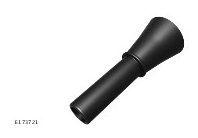
Vehicles with a diesel engine are supplied with an active misfueling device, e.g., a visible metal flap in the filler neck. These vehicles require the use of the emergency funnel supplied with the vehicle to refill the fuel tank with a fuel can. Insert the funnel into the filler neck, fully and squarely, to open the active misfueling device. See ACTIVE DIESEL MISFUELING PROTECTION DEVICE.
If the vehicle does run out of fuel, seeking qualified assistance is advisable.
WATER IN FUEL
If the instrument panel displays a warning message, an excessive amount of water has been collected in the fuel system. In this event, consult a retailer/authorized repairer as soon as possible. Water in fuel can damage engine components or the fuel system.
DIESEL ENGINES
- Running out of fuel draws air into the fuel system and may cause serious damage to the fuel injection system.
- In this event, seek qualified assistance immediately.
- If the fuel gauge indicates a low fuel level, or the low fuel warning lamp illuminates, refuel the vehicle as soon as possible.
- A minimum of 1.1 gallons (4.5 L) of fuel is required to enable the engine to be restarted.
- After refueling, use the following procedure:
- With the brake pedal pressed, press and hold the engine START/STOP button and crank the engine for 5 seconds.
- Release the START/STOP button.
- With the brake pedal pressed, press and release the START/STOP button to crank the engine. The engine should start within approximately 5 seconds.
If the engine does not start, leave the vehicle’s ignition switched on for 10 seconds, then repeat the complete procedure.
Do not crank the engine for longer than 30 seconds continuously. Doing so may cause damage to the vehicle’s engine.
FUEL FILLER FLAP
Make sure the relevant safety warnings have been read and understood before refueling the vehicle. See SAFETY PRECAUTIONS.
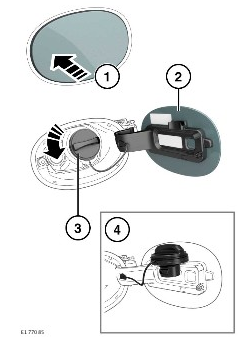
The fuel filler flap is located on the right side of the vehicle, at the rear. To operate, proceed as follows:
- Press and release the rear of the fuel filler flap to unlatch.
- Pull the flap open. The label on the inside of the flap indicates the correct fuel for the vehicle.
- Turn the filler cap counterclockwise to undo it.
- Use the retaining clip to keep the filler cap out of the way while fueling.
- When replacing the filler cap, turn it clockwise until the ratchet clicks.
- To close the filler flap, push the flap until it is securely latched.
- Plug-in Hybrid Electric Vehicles (PHEVs) also incorporate a locking fuel filler flap. See FUEL FILLER FLAP LOCK.
FUEL FILLER FLAP LOCK
Make sure that the vehicle is refueled shortly after the refueling button is pressed. Failure to do so may result in the fuel tank not being filled to the required level. If in doubt, check the fuel level gauge in the instrument panel before continuing the journey, to prevent running out of fuel.
Plug-in Hybrid Electric Vehicles (PHEV) have a locking fuel filler flap and an isolation valve on the fuel tank.
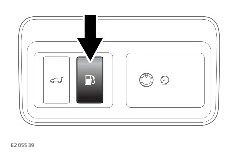
To enable refueling, carry out the following:
- Switch off the vehicle’s ignition, apply the Electric Parking Brake (EPB), and make sure that the transmission is engaged in Park (P).
- Press the refueling button located in the lower switch panel on the driver’s side of the dashboard. The isolation valve on the fuel tank opens to depressurize the fuel tank. The fuel filler flap unlocks. The instrument panel displays a message to confirm that the fuel filler flap is unlocking.
- The instrument panel displays a message to confirm that the fuel filler flap is unlocked and the vehicle can be refueled. See FUEL FILLER FLAP.
The isolation valve on the fuel tank remains open for approximately 10 minutes, at which point the valve shuts, preventing further refueling. If further refueling is required, repeat the above process to open the isolation valve on the fuel tank.
Make sure that the vehicle is stationary. The fuel filler flap does not unlock, and the isolation valve on the fuel tank does not open if the vehicle is moving. The instrument panel displays a message to confirm that the vehicle’s speed is too high.
Make sure that the fuel filler flap is closed after refueling. The instrument panel displays a message to confirm that the fuel filler flap is not fully closed. If a fault is detected on either the fuel filler flap system, or on the isolation valve system on the fuel tank, the instrument panel displays a message. In this event, consult a retailer/authorized repairer or roadside assistance. See INCONTROL REMOTE SMARTPHONE APP.
FUEL FILLER
Make sure the relevant safety warnings have been read and understood before refueling the vehicle. See SAFETY PRECAUTIONS.
Check the fuel pump information carefully, to make sure that the correct fuel is used to refuel the vehicle. Inadequate fuel can reduce engine performance and may cause permanent damage to engine components.
If the vehicle is filled with incorrect fuel, it is essential to seek qualified assistance before starting the engine. Inadequate fuel can reduce engine performance and may cause permanent damage to engine components. Filling station pumps are equipped with automatic cut-off sensing to avoid fuel spillage. Fill the tank until the filler nozzle automatically cuts off the supply. Do not attempt to fill the tank beyond this point.
ACTIVE DIESEL MISFUELING PROTECTION DEVICE
Do not force an incorrectly sized fuel pump nozzle into the filler neck. Forcing an incorrectly sized fuel pump nozzle into the filler neck may result in damage to the vehicle.
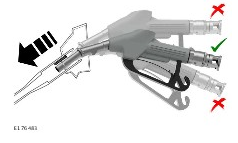
Vehicles with a diesel engine have an active misfueling protection device. A metal flap is visible in the fuel filler neck when the fuel filler cap is removed. The active misfueling protection device helps to prevent the fuel tank from being filled with the incorrect fuel, e.g., gasoline. Automatic release occurs if a correctly sized, diesel fuel pump filler nozzle is inserted, fully and squarely, into the vehicle’s fuel filler neck, as illustrated.
To refuel with a fuel can, use the emergency funnel supplied with the vehicle. See RUNNING OUT OF FUEL.
FUEL TANK CAPACITY
Avoid the risk of running out of fuel. Never intentionally drive the vehicle when the fuel gauge indicates that the tank is empty. When refueling the vehicle after the indicated range reads zero, it may not be possible to add the maximum fuel quantity. The fuel tank retains a small reserve of fuel. See CAPACITIES.
